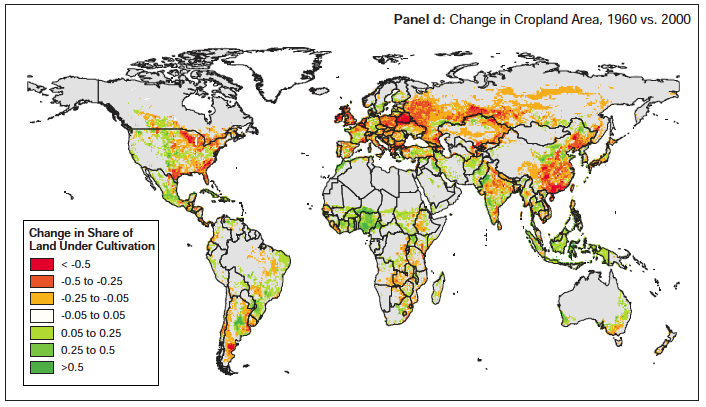A strange blind spot... I'm not sure what brought this to mind last night, but I got to thinking about several conversations I've had over the years related to world population (of humans) and food supply. Not all of these conversations were with younger people, so the blind spot I'm referring to here isn't strictly related to age.
Here's the blind spot: many people (Americans, at least) don't remotely understand what a change there's been in food production, world wide, over the past 50 or 60 years. And they most especially don't understand why this has happened.
In my youth, the world's population was roughly half what it is today, and world food production was insufficient for the needs of that much smaller population. That simple pair of facts was enough to ensure that millions of people were starving or severely malnourished. I saw this personally when I traveled throughout southeast Asia and Africa while I was in the U.S. Navy in the '70s. I saw children with the distended bellies characteristic of starvation. I participated in emergency food deliveries to the east coast of Africa during widespread famines.
Today the situation has completely turned around. While the world population has doubled, the world's food production has tripled. The world now makes more than enough food for all its human inhabitants. The only large populations of people starving or malnourished today are doing so for political reasons (think North Korea or Venezuela) – not because the food isn't available.
So how did this quite radical change come about, and especially how did it happen within the span of a single human life? It's a big, complicated question with a complex answer, but it can be simplified to two causes: Norman Borlaug and capitalism. Yes, really.
If you don't know about Norman Borlaug, you really should get yourself educated. The man was amazing, and his work has probably saved over a billion people from starving to death. Yes, really.
The much-maligned capitalism, via its inherent profit motive, has increased agricultural production everywhere it has touched. The map above right shows net agricultural production for the two years ending in 2001. The greenish countries are net agricultural exporters. I couldn't find a map to illustrate this, but as of a few years ago China is now a net exporter, and India is on the cusp of being so. There are also several countries in Africa that are now net exporters, including South Africa. You can see that the current net importers are closely correlated with those countries that don't have effective capitalist economic systems. A couple of countries serve as beautiful examples. First, there's China: the country's agricultural output very closely tracks its adoption of capitalism in agriculture (the last sector the government reformed). It is an astonishing textbook example of the power of the profit incentive – just 40 years ago, people in China were still starving because the country could neither produce enough food to feed itself nor afford to buy it. Now it produces enough food to export, despite its population having more than doubled. Then there's little Israel, which will be a net food exporter within a few years. It is surrounded by countries with similar geography and climate, and yet Israel alone is anywhere near self-sufficiency on food. Even Egypt with its huge advantage of the Nile valley still isn't nearly self-sufficient. The only relevant difference between Israel and its neighbors is its full-throated adoption of capitalism.
Here's yet another piece of that blind spot: despite the amazing increases in food production I outlined above, the amount of cultivated land in the world is declining. Yes, really. Anyone who travels extensively across the U.S. can tell you this first hand: land is returning to forest in many parts of the country. In some parts of the world, particularly in developing countries, land under cultivation is increasing. In other parts of the world – particularly in developed countries, land under cultivation is decreasing. The net, worldwide, is a peak around 2012, and a gradually increasing decline since then. Agriculture is so efficient these days that it takes less and less land to feed an increasing population.
One last piece of the puzzle that I've been surprised people are generally unaware of: the world's population is increasing at a declining rate. In fact, fertility rates are generally the lowest amongst the more developed nations (think Japan, Germany, etc.) and the highest amongst the undeveloped nations (Africa and southeast Asia, especially). The U.S. is a bit of an anomaly in that mix – we still have a relatively high fertility rate. Overall, though, the world's fertility rate is declining, and while opinions vary on when we might reach peak population, few economists or demographers disagree that we will reach that point, and most agree it will be before the end of the current century.
This story I've tried to encapsulate here in short form is, in my view, one of the most amazing stories in all of human history – and yet so many people who are actually living through this don't seem to even be aware of it!


